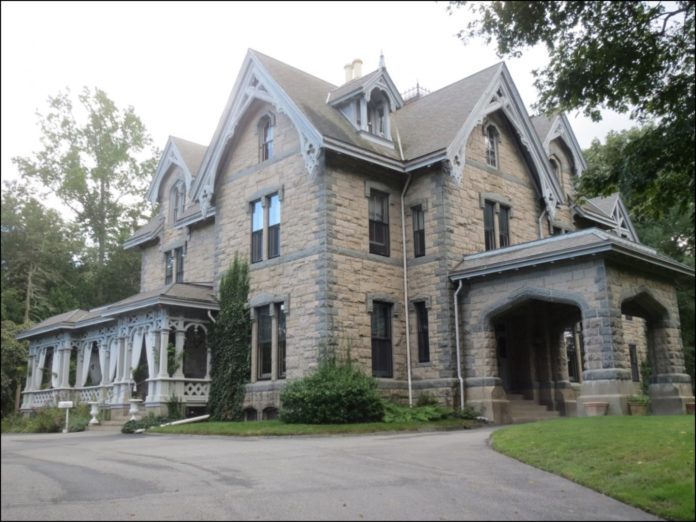
WARWICK – The National Park Service has added Cedar Hill, a historic estate in the Cowesett neighborhood of Warwick, to the National Register of Historic Places, according to Edward F. Sanderson, executive director of the R.I. Historical Preservation & Heritage Commission.
Built between 1871 and 1877, Cedar Hill is a country estate founded by a wealthy industrialist family.
Located on a 27-acre hilltop overlooking Greenwich Bay, the estate’s original carriageway winds uphill from Post Road, circling the three-and-a-half story granite mansion. Consistent with the Gothic Revival style of architecture, the house has pointed-arch windows, ornate bargeboard trim, hip-roofed porte-cochere and a wrap-around porch, according to information from the commission. The estate’s well-preserved interior is filled with spacious rooms and extensive late Victorian decorative woodwork, plasterwork and painted finishes. The mansion also features gardens, extensive lawns and wooded areas and three significant outbuildings which include an 1872 wood-frame carpenter’s shop, a 1906 brick stable and a 1930 fire station.
“Cedar Hill’s well-preserved and exceptional architectural and decorative features make it one of the most elaborate historic mansions in the West Bay region,” said Sanderson in a statement.
The state commission released detailed history about the home, which was constructed for Alfred Reed Jr. and Elizabeth Ives Slater after they were married in 1870.
Reed’s father made his fortune in the East India trade and in textile manufacturing, and Slater was a descendent of textile industrialist Samuel Slater. By 1871 construction had begun on the couple’s expensive new home on Reed family land. Following a series of land transfers, the property was deeded solely to Elizabeth Ives Slater Reed, whose father William S. Slater paid for the couple’s home.
By March 1877, the cost for Cedar Hill totaled about $136,000 – more than $3 million today.
The interior design of the mansion reflects the Victorian concern for the comforts of home and an attention for ornament, with painted wall and ceiling stencil designs, plaster ceiling medallions, ornate cornice moldings, stained or varnished woodwork, tile floors for primary hallways, hardwood floors with Oriental rugs for first-floor rooms and straw matting on bedroom floors. The reception room features Egyptian-style decorative stenciling, mantelpiece, mirror, window cornices, furniture and light fixtures. The home was fitted with the most modern luxuries of the 1870s: indoor plumbing for multiple bathrooms, steam heating, naphtha gas lighting fixtures, as well as electric bells and speaking tubes to summon servants, a burglar alarm and fire protection.
The estate passed to Elizabeth’s oldest daughter Helen Slater Reed Allen (1872-1952) in 1917, who installed electric lighting in the 1920s and significantly expanded the size of the property, acquiring pasturage, croplands, orchards and woodlands, including several small farms and a gravel bank that provided the material for the estate’s roads.
Her daughter Anne “Nancy” Crawford Allen (1908-1997) built a small fire station behind the main house and established the Cedar Hill Volunteer Fire Department in 1931, where she was subsequently recognized by the International Association of Fire Chiefs as the first woman fire chief. Married to Monterey L. Holst in 1940, she inherited the estate from her mother in 1952.
Nancy’s daughter Anne Dietrich Holst is the fourth generation to reside at Cedar Hill. In 2004, Holst and business partners Wayne and Christine E. Cabral opened Cedar Hill to the public as the “Clouds Hill Victorian House Museum,” offering special exhibits and programs while preserving the house’s original materials, finishes and furnishings. Cedar Hill remains a private residence, and the museum is open to visitors by appointment.
The National Register listing results in special consideration during the planning of federal or federally-assisted projects and makes properties eligible for federal and Rhode Island tax benefits for historic rehabilitation projects. Owners of private property listed on the National Register are free to maintain, manage or dispose of their property as they choose. As the state office for historic preservation, the Historical Preservation & Heritage Commission is responsible for reviewing and submitting Rhode Island nominations to the National Register.












